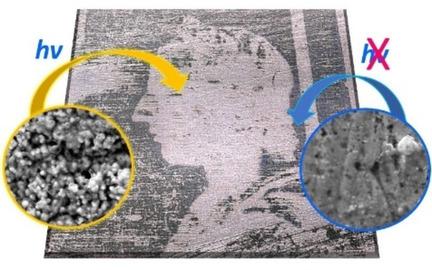当前位置:
X-MOL 学术
›
ChemPlusChem
›
论文详情
Our official English website, www.x-mol.net, welcomes your
feedback! (Note: you will need to create a separate account there.)
Highly Photosensitive Daguerreotypes and their Reproduction: Physico-chemical Elucidation of Innovative Processes in Photography Developed around 1840 in Vienna.
ChemPlusChem ( IF 3.0 ) Pub Date : 2019-10-30 , DOI: 10.1002/cplu.201900467 Valentina Ljubić Tobisch 1 , Wolfgang Kautek 1
ChemPlusChem ( IF 3.0 ) Pub Date : 2019-10-30 , DOI: 10.1002/cplu.201900467 Valentina Ljubić Tobisch 1 , Wolfgang Kautek 1
Affiliation

|
A physico-chemical elucidation of the first photographic technology that allowed manifold reproduction is presented. An etched daguerreotype manufactured around 1840 in Vienna, preserved by the Technisches Museum Wien, served as a case study. Surface analysis showed that the photographic process involved the formation of colloidal Ag nanoparticles with sizes of 30-120 nm with shell layers consisting of Ag2 O, Ag2 S, and some AgCl. This breakthrough photographic technique provided a hitherto unachieved high sensitivity because of various halogenide mixtures without the use of Hg. The image development consisted of the reduction of the Ag halides by H2 SO3 created by the hydrolysis of S2 Cl2 leading to the formation of Ag nanoparticles adjacent to the Ag nuclei of the latent image. The fixing of the image was performed either by KCN or by Na2 S2 O3 . The investigated plate exhibits etched areas with Ag2 O conversion layers and no Cl or S. The gum arabic use for etching preferentially wetted the exposed Ag nanoparticle regions so that unexposed areas could be etched by HNO3 .
中文翻译:

高度光敏的Daguerreotypes及其复制:摄影中创新过程的物理化学解释1840年左右在维也纳发展起来。
介绍了允许多重复制的第一种摄影技术的物理化学解释。维也纳Technisches博物馆保存了1840年左右在维也纳制造的蚀刻刻版刻版画,作为案例研究。表面分析表明,照相过程涉及形成大小为30-120 nm的胶体Ag纳米颗粒,其壳层由Ag2 O,Ag2 S和一些AgCl组成。这种突破性的照相技术由于不使用汞而形成的各种卤化物混合物,提供了迄今为止无法实现的高感光度。图像显影包括由S2 Cl2水解产生的H2 SO3还原卤化银,从而导致在潜像的Ag核附近形成Ag纳米颗粒。图像的定影通过KCN或Na2 S2 O3进行。
更新日期:2019-10-30
中文翻译:

高度光敏的Daguerreotypes及其复制:摄影中创新过程的物理化学解释1840年左右在维也纳发展起来。
介绍了允许多重复制的第一种摄影技术的物理化学解释。维也纳Technisches博物馆保存了1840年左右在维也纳制造的蚀刻刻版刻版画,作为案例研究。表面分析表明,照相过程涉及形成大小为30-120 nm的胶体Ag纳米颗粒,其壳层由Ag2 O,Ag2 S和一些AgCl组成。这种突破性的照相技术由于不使用汞而形成的各种卤化物混合物,提供了迄今为止无法实现的高感光度。图像显影包括由S2 Cl2水解产生的H2 SO3还原卤化银,从而导致在潜像的Ag核附近形成Ag纳米颗粒。图像的定影通过KCN或Na2 S2 O3进行。











































 京公网安备 11010802027423号
京公网安备 11010802027423号